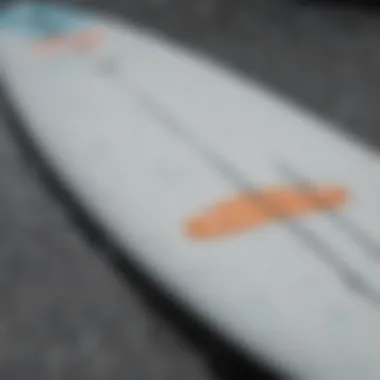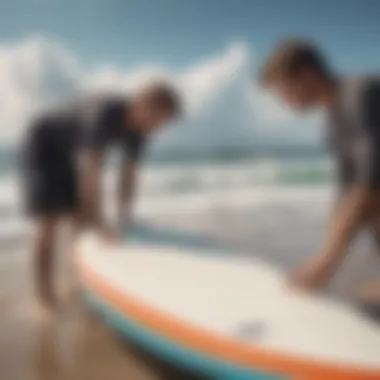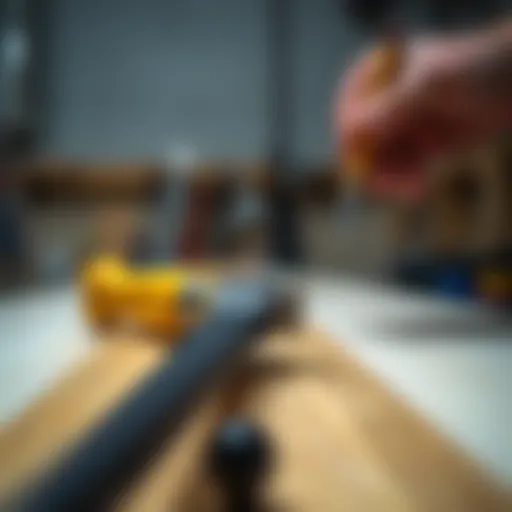Top Soft Top Surfboards for New Surfers


Intro
For those new to surfing, the choice of surfboard can feel like standing at the edge of a vast ocean—daunting and overwhelming. Enter the soft top surfboard, a beacon of hope for beginners ready to ride their first waves. These boards offer stability, safety, and a plethora of features tailored for those just starting their surfing journey. In this guide, we will take you through a comprehensive examination of soft top surfboards, spotlighting their advantages, diving into essential features, and showcasing some of the best models available today.
Wading into the world of surfing might seem simple, but like every sport, it has its nuances. A soft top surfboard serves as a reliable companion, providing both buoyancy and durability, not to mention a friendly interface for those wobbly first attempts. Making an informed choice today can pave the way for a lifetime of enjoyment on the waves.
Surfboard Reviews
Types of Surfboards: An Overview
Surfboards come in myriad shapes and sizes, but for beginners, the spotlight shines brightly on soft tops. These boards are distinguished by their foam tops, which foster a forgiving ride and reduce the risk of injury during spills and tumbles. Soft tops venture into two main types:
- Foam Surfboards: Typically extensive, these boards provide exceptional stability, making them ideal for beginners. Their lightweight design ensures that paddling is a breezy affair.
- Hybrid Boards: Combining features of soft tops with traditional boards, hybrids offer versatility. They are slightly heavier due to added materials but offer a balance of performance and safety.
Both types cultivate confidence in new surfers, but foam surfboards often take the cake when it comes to comfort and ease.
Best Surfboards for Beginners and Pros
Here’s a handpicked selection of soft top surfboards that stand out in the crowd:
- Wavestorm 8' Foam Surfboard: This classic board is widely recognized in surf schools and beginner lessons. Its size and stability make dunking in the waves a piece of cake for first-timers.
- South Bay Board Co. 8’ Soft Top Surfboard: With a blend of durable construction and great wax-friendly surface, this board caters both to new surfers and those looking to refresh their skills.
"Choosing the right board means more than just length and color—it's about finding a surfboard that aligns with your comfort and visions of riding waves."
- Catch Surf Beater 54" Soft Top: Though compact, this board is fantastic for surfers who want to progress rapidly. Its shorter length provides a great workout and excellent maneuverability.
Each of these surfboards serves as a stepping stone towards mastering the art of surfing without sacrificing safety or enjoyment. As you make your purchase, keeping personal preferences and comfort in mind, rather than mere price tags, will yield long-term returns in your surfing adventure.
Understanding Soft Top Surfboards
When embarking on a surfing journey, understanding soft top surfboards is paramount. This section aims to acquaint beginners with the fundamental aspects of these boards, their advantages, and why they often come highly recommended for novices venturing into the waves.
Defining Soft Top Surfboards
Soft top surfboards are, as the name suggests, surfboards that feature a soft, cushioned deck. Unlike traditional hard-top surfboards, which are made from fiberglass and can be quite rigid, soft tops are covered in soft foam that provides a forgiving surface. This structure offers added safety, making them particularly appealing for beginners. The soft tops reduce the risk of injury, both to the surfer and to others in the water. When a novice falls (which is inevitable), the soft surface can help prevent bumps and bruises.
Key Characteristics of Soft Top Surfboards:
- Foam Deck: Soft and safe, reducing risk of injury.
- Durability: Generally more resistant to dents and scratches.
- User-Friendly: Easier handling in various conditions for inexperienced surfers.
Soft top surfboards often come in a range of sizes and shapes, catering to different styles of surfing. By offering stability and balance, these boards can assist beginners in getting their feet wet without feeling overwhelmed.
Materials and Construction
The materials used in soft top surfboards are crucial for their performance and longevity. Primarily, they consist of a foam core, usually made from polyethylene or another type of durable foam. The outer layer is often a combination of soft foam on top and a hard plastic bottom, which helps the board glide smoothly on the water.
Here’s a closer look at the elements at play:
- Foam Core: Provides buoyancy and lightness, aiding in paddle efficiency.
- Soft Top Layer: Enhances comfort when paddling and provides a safer surface for learning.
- Hard Bottom: Often made from high-density polyethylene, it allows for better speed and maneuverability.
In terms of construction, these boards typically undergo a process that combines molding and lamination, ensuring they are built to last while remaining lightweight. This unique blend of materials plays a significant role in how soft top surfboards operate in the water, allowing beginners to ride the waves with confidence. The lighter weight also means beginners can paddle out without feeling like they're carrying a ton of bricks.
As a novice, selecting a soft top surfboard that knows what it's made of can aid in enhancing your surfing experience, enabling you to focus on mastering skills rather than worrying about your equipment.
Why Beginners Prefer Soft Top Surfboards
When it comes to surfing, new riders often find themselves navigating a whole ocean of options. Soft top surfboards stand out for beginners because they offer a blend of safety, stability, and ease of use. These boards are not just a passing trend; they serve as a cornerstone for novice surfers to build their skills. Understanding why beginners gravitate towards these boards can help clarify their pivotal role in the surf culture.
Safety Considerations
Safety is always a top priority for those just dipping their toes into surfing. Soft top surfboards are particularly appealing for beginners due to their cushioned surfaces. This cushioning significantly reduces the risk of injury during wipes-outs, which are pretty common when anyone is starting out. Imagine getting tossed off the board into the water; the last thing you want is to be smacked by a hard surface. Health professionals know that many beginner injuries stem from hard boards that can cause painful bumps or bruises.
Furthermore, soft tops often come with rounded edges, thereby minimizing the chance of sharp impacts. This design is not only gentler on the body but also helps in creating a welcoming experience. For beginners, it’s more than just about learning to ride a wave; it’s about fostering the confidence to get back on the board after a tumbler.
"Soft top surfboards are the gentle giants of the wave riding world—perfect for easing into the sport without severe consequences."
A common misconception is that soft tops don’t provide enough performance; however, many models are designed with stability in mind. With a wide base and optimal buoyancy, they offer an extra layer of security. As new surfers paddle out, feeling secure on their board can make a world of difference on how quickly they progress.


Ease of Use
For someone just starting in surfing, the learning curve can feel steep. This is where soft top surfboards really shine. They are typically wider and thicker than traditional boards, which translates to better stability on the water. A beginner can practice paddling and balancing without being thrown off by rough waters or strong currents. The added volume makes it easier to pop up, a crucial skill for catching waves.
The lightweight nature of these boards means that they are easier to carry to and from the beach. New surfers often find the logistics of heading to the surf daunting, particularly with heavier boards. A soft top removes that barrier, encouraging learners to make surfing a routine part of their lives.
Moreover, soft top surfboards are often simpler in their design compared to other types. Many of them come at budget-friendly prices, making them accessible to novices who might still be undecided if surfing is their forever passion. A softer entry into the sport fosters a sense of enjoyment, motivating beginners to get out in the water repeatedly.
Combining safety with ease of use, soft top surfboards present a compelling case for novice riders. In a sport where confidence can dictate success, the right gear can set the tone for a fulfilling surfing journey.
Key Features to Look For
When it comes to choosing a soft top surfboard, being aware of the essential features can make all the difference. Soft top boards aren’t just child’s play; they come with specific characteristics that help maximize your experience in the water. Knowing what to look for can help new surfers find their footing more easily and build confidence to progress.
Length and Volume
Length and volume are two crucial factors that can significantly affect your surfing journey. Generally, longer boards offer greater stability, which is ideal for beginners learning to catch waves. The fuller volume provides more buoyancy, making it easier to paddle and balance.
When you're just starting, boards around 8 to 9 feet are often recommended. It's like having training wheels on your bike; they keep you steady as you build skills. However, the right fit may also depend on your body size. A heavier person might want to lean towards a thicker board, while a lighter individual can work well with something a bit slimmer. Always remember, the more stable you feel on the water, the more fun you'll have. Finding that sweet spot in length and volume will set you off on the right foot.
Width and Shape
The width and shape of a soft top surfboard can greatly impact maneuverability and control in the waves. Wider boards provide more surface area, which translates to increased balance. That can be a real lifesaver as you're trying to stand up on your first few waves. A wider outline is also generally more forgiving when it comes to balance.
However, the shape of the board also matters. A slightly more rounded nose can help with ease of entry into waves, while a pointed nose might offer more speed. If you think about it, choosing the right shape is kind of like picking the right shoes for a race; the better the match, the better your performance will be.
Fin Systems
Fins play a surprisingly significant role in how a board performs. Soft top surfboards come with different fin setups: single fin, thruster (three fins), or even quad (four fins). For beginners, a single fin setup goes hand in hand with stability; it won’t steer you wildly off course while you’re still working on your balance.
As you advance, experimenting with more fins can give you different advantages like tighter turns or more speed. Most of these boards use removable fins, which is also an advantage; it allows you to swap them out based on your comfort level or even the types of waves you’re riding. Easy to adjust, easy to improve.
"Choosing the right surfboard is not just about style; functionality is key for beginners."
Top Soft Top Surfboards for Beginners
When it comes to surfing, choosing the right board can make or break your experience. For beginners, soft top surfboards stand out as excellent choices. They provide a safe landing, are easy to handle,** and offer more stability, making it much simpler to catch those first waves. This section dives into specific models that cater to newcomers, ensuring you have the right tools to start your surfing journey.
Model #1: Catch Surf Beater
The Catch Surf Beater 54 is a versatile board that many novices have come to love. Its shorter length allows for nimble maneuvering while still providing a solid platform for stability. The soft foam top reduces the risk of injury, which is an important consideration for beginners still mastering their balance.
Benefits:
- Lightweight construction makes it easy to carry.
- It performs well in small to medium waves, setting you up for success on your early sessions.
- The vibrant colors are not just a treat for the eyes; they also make the board easy to spot in crowded waters.
Model #2: Wavestorm ' Classic
A household name among beginner surfers, the Wavestorm 8' Classic combines affordability with performance. This board is often found in surf schools due to its reliability and ease of use. It comes with a soft outer layer that handles wear and tear remarkably well, providing a long-lasting surf experience.
Benefits:
- Its length offers enhanced stability, giving you more confidence to paddle out.
- Comes with a thruster fin setup, allowing for smoother rides.
- Very budget-friendly, appealing to those who want to ease into the sport without breaking the bank.
Model #3: South Bay Board Co. The Odysea '
The Odysea by South Bay Board Co. is a favorite for those wanting a bigger board without sacrificing comfort. It boasts a soft top design and a fun shape that encourages beginners to practice paddling and riding waves. The board is lightweight, making it easy to transport.
Benefits:
- The board's width provides extra stability, which is perfect for novices still finding their feet.
- Multiple sizes are available, allowing you to choose based on your height and weight for optimal performance.
- Features a fun design that makes the surfing experience enjoyable right from the start.
Model #4: NSP Elements Soft Top '
The NSP Elements Soft Top model is designed for durability and ease of use. It features a thick foam core that can withstand a bit of rough handling, making it ideal for beginner surfers who may drop their board now and then. This model’s rounded nose and tail design provide enhanced balance and control, which is crucial for learning.
Benefits:


- The robust construction ensures longevity.
- Easy to use in varied conditions, helping users adapt as they learn.
- The soft deck helps minimize injuries, crucial for the learning process.
Model #5: BIC Sport '" Soft Top
Finally, the BIC Sport 7'3" Soft Top is perfect for those still growing into the sport. It's not too long, making it manageable for novices while still providing reliable performance in various surf conditions. With its rigid frame and soft exterior, it combines the best of both worlds.
Benefits:
- Ideal size for lightweight surfers, making it user-friendly.
- A great option for learning various maneuvers without needing to go for a traditional hard board.
- Offers great buoyancy, which aids in paddling efficiency.
"Choosing the right soft top surfboard is crucial for a successful start in surfing. Each model has sth special to offer, and it’s wise to consider personal preferences and surf conditions before making a purchase."
Whether you are drawn to the aesthetics, the price point, or the features, each of these soft top surfboards has something worth considering. Finding the right fit can enhance not only your confidence but also your enjoyment of the sport. Saturate your mind with knowledge about each model, and you'll be well-equipped as you splash into the world of surfing.
Comparative Analysis
Understanding the comparative analysis of soft top surfboards is crucial for beginners diving into the world of surfing. This section aids surfers in making informed decisions by breaking down performance metrics and price considerations. Knowing the right board can significantly affect your initial experience, influencing not just your enjoyment, but also the rate at which you learn. Beginners often feel overwhelmed by choices available. Therefore, this comparison brings clarity to models on the market, allowing surfers to see what features work best for them based on various factors.
Performance Overview
In the realm of surfboards, performance can make or break your experience in the water. Key aspects of performance include stability, speed, maneuverability, and buoyancy. Each model has different attributes that can cater to various surfing styles.
- Stability: A beginner typically prefers a wider board that offers better balance. Wider boards usually have more volume, which enhances stability, making it easier to catch waves.
- Speed: A surfboard's shape and material composition influence its speed. Softer materials generally create a slower board, but for learners, this means more control and less chance of wiping out.
- Maneuverability: The board’s length and shape dictate how easily it can turn or pivot. Shorter boards might offer enhanced maneuverability but can prove difficult for novices.
To efficiently compare, consider aligning models against your skill level and the types of waves you plan to surf. For example, if you’re mostly surfing small, mellow waves, a soft top with a larger surface area might be ideal. A table summarizing these aspects can be particularly helpful:
| Board Model | Stability | Speed | Maneuverability | | Model 1 | High | Moderate | Low | | Model 2 | Moderate | High | Moderate | | Model 3 | Low | High | High |
Such data provides a quick glance at how different models perform under various conditions. This can save time and reduce confusion when selecting the right surfboard.
Price Range Comparison
When it comes to surfing, price often plays a significant role in decision-making, especially for beginners who may not want to break the bank on their first board. Soft top surfboards come in various price ranges, generally influenced by construction materials, brand reputation, and additional features.
Beginner boards typically range from approximately $200 to $600. Understanding this range can clarify budget decisions and expectations.
- Budget Options ($200 - $300): These boards usually provide adequate durability and functionality. Brands like Wavestorm offer quality options at lower prices, making them accessible for those just starting out.
- Mid-Range ($300 - $450): These boards often offer enhanced performance features. Brands such as South Bay Board Co. strike a balance with more advanced materials without being too costly.
- Premium Boards ($450 - $600): Higher-end surfboards may feature advanced construction techniques or unique designs tailored for specific performance needs. These boards are generally intended for the dedicated surfer looking to invest in their gear.
"Choosing the right surfboard should complement not only your skill level but also jumpstart your journey with a solid experience on the waves."
By analyzing both performance metrics and price considerations, beginners can navigate their options more confidently, setting the stage for a fulfilling surfing adventure.
Maintenance and Care Tips
Caring for your soft top surfboard isn’t just about keeping it clean; it’s about ensuring its longevity and performance in the water. This section dives into vital maintenance practices that help maintain the integrity of your board and enhance your overall surfing experience. From the moment you take your board out of the box, maintaining it can play a crucial role in its durability and your safety.
Cleaning and Storage
Cleaning your surfboard can feel like a chore, but investing time in it pays off in the long run. After each surf session, rinse your board with fresh water. This helps to remove salt, sand, and any other debris that could wear down the surface or cause damage over time. It might seem tedious, but even a quick rinse can do wonders.
When storing your board, consider a few key factors:
- Keep it cool: Avoid leaving your surfboard in direct sunlight for long periods. UV rays can degrade the materials, making them less effective.
- Flat and unsupported: Store your board flat or on a soft rack. Propping it against something can create pressure points that may compromise its shape.
- Protective gear: Use a board bag for added protection. It shields your surfboard from knocks and scrapes when you're on the move or during storage.
Paying attention to these details might seem minor, yet they significantly contribute to your board’s lifespan.
Repairs and Minor Fixes
Even the best surfboards can suffer dings and scratches. Fortunately, many of these repairs are straightforward and can be done at home, saving you both time and cash.
If you notice a small puncture or crack:
- Gather your materials: You’ll need sandpaper, epoxy resin, and a clean cloth. Some local surf shops might even have repair kits designed for soft top boards.
- Prepare the area: Lightly sand the damaged area to ensure a good bond for the epoxy. Clean off any dust with a dry cloth.
- Apply the epoxy: Follow the specific instructions on the resin package. Typically, push it into the damaged area and smooth over the surface with a small tool.
- Let it cure: Patience is key here. Allow the epoxy to dry completely, as rushed repairs might lead to bigger problems down the line.
Keep in mind, for larger or more complicated repairs, a professional might be more suited for the job. It's all about keeping your board in top shape and making sure your time in the water is enjoyable and safe.
"An ounce of prevention is worth a pound of cure."
Ensuring that your surfboard is well-kept goes a long way in enhancing your surfing experience and avoiding unexpected mishaps on the waves.


Taking the time to clean, store, and repair your surfboard prepares you for the next adventure. It’s these small efforts that contribute to a long-lasting relationship with your surfboard and the ocean.
Selecting the Right Surfboard for Your Needs
Choosing the right surfboard is crucial for beginners looking to make their mark on the waves. Not only does the board influence your experience, but it’s also key in ensuring you progress at a pace that suits you. While it might seem overwhelming with all the options out there, understanding a few key elements can help demystify the selection process.
Assessing Personal Skill Level
Knowing your skill level is the cornerstone of making an informed purchase. If you’re just starting out, it’s wise to lean towards boards that offer stability and ease of paddling. A wider and thicker soft top board, for instance, provides better buoyancy.
- Beginners: Look for soft tops that are at least 8 feet long. This length helps you catch waves more easily and stay stable while learning to balance. If you can’t ride to save your life, a longer board can feel like a safety net.
- Intermediate surfers: You might want to consider options that are slightly shorter, perhaps around 7 feet. These boards still offer some stability but allow for a bit more maneuverability as your skills develop.
- Skill Development: Keep in mind that if you outgrow your board’s usability, your journey towards mastering surf techniques could stall, resulting in frustration.
Matching Conditions to Surfboard Choice
Various surf conditions require different board types. New surfers should consider several factors in the environment they plan to surf.
- Wave Size: For instance, bigger boards work well in small surf, while smaller boards perform better in larger waves. Selecting a board that can handle the typical wave conditions at your local beach is of utmost importance.
- Beach Type: The bottom of the ocean can vary. Sandy bottoms are friendly for beginners, so a wider soft top surfboard is a solid choice. Conversely, rocky bottoms could be more treacherous; hence, broader boards not only keep you afloat but also help you avoid wipeouts.
"A well-chosen surfboard will not only match the conditions of your local surf but will also promote growth in your skills, making every session enjoyable."
Ultimately, by assessing your skill level and matching your board choice to surf conditions, you lay the groundwork for a fruitful surfing experience. This tailored approach ensures that your initial ventures into surfing are both safe and rewarding.
Transitioning to More Advanced Surfboards
As novice surfers grasp the basics of riding waves on soft top boards, the inevitable question arises: when is the right time to transition to more advanced surfboards? This phase is not merely about swapping boards; it reflects a deeper understanding of the sport and a readiness to take on greater challenges. Making the jump can enhance surfing skills, improve performance, and open the door to a wider variety of surfing experiences.
With various surfing conditions and personal preferences, moving on from a soft top surfboard is an essential part of a surfer’s journey. This transition should be considered when a surfer is comfortable paddling, balancing, and riding waves consistently. The benefits of upgrading include increased maneuverability, better wave response, and the ability to surf in more varied conditions.
When considering the switch, it's vital to keep in mind specific elements: the maneuverability of the new board, the types of waves in your local surf spots, and personal comfort dimensions. Having the right board can bring a refreshing change to the experience.
"The right board can change the way you ride and the way you feel on the waves. Once you step up, every session becomes a learning opportunity."
When to Upgrade
Determining the optimal timing for an upgrade involves self-assessment of skill growth and confidence. There are several indicators that may suggest it’s time to look for a new board:
- Consistent Performance: If you find yourself easily catching waves and riding them to shore, it’s likely you’ve outgrown your soft top.
- Desire for Skill Expansion: If you find the limitations of the soft top hindering your progression, you might feel ready to tackle a shorter or harder board that offers greater responsiveness.
- Increased Surfing Frequency: Frequent sessions at different surf spots often require adaptable equipment; having a board suited to varying conditions can be crucial.
These signs indicate that you have developed a solid foundation that can support a more advanced surfboard. It’s important to approach this decision thoughtfully, so consult fellow surfers or instructors for additional insights.
Choosing the Next Board
Selecting your next surfboard after transitioning is both exciting and challenging. Consider these factors to help guide your choice:
- Surfboard Type: Decide whether you want a fish, shortboard, or hybrid board based on the waves you typically ride. Fish boards are great for softer, smaller waves, while shortboards excel in more powerful surf.
- Volume and Size: Depending on your weight and skill level, pay attention to volume. A lower volume offers more maneuverability but requires better skills to handle.
- Design and Materials: A foam core makes for a lighter ride, while epoxy construction might offer a more durable and lively option.
- Fin Setup: Experiment with different fin configurations for better handling in various conditions; a thruster setup is popular for versatility.
Engaging with local surf shops or online forums can reveal firsthand experiences that are invaluable in making an educated decision. Sites like Reddit and local surf clubs can provide insights into what boards work best in your preferred surf spots.
The End: Building a Solid Foundation
The conclusion of this article highlights the pivotal role that soft top surfboards play for new surfers looking to gain confidence and skill in the water. Choosing the right equipment lays the groundwork for a much smoother surfing journey—one where challenges can be met with the right tools in hand. There’s more to this than simply picking an attractive board; it’s about aligning the board’s characteristics with your personal aspirations in the sport.
New surfers often navigate through a sea of options and technical details when selecting their first board. Understanding the key features, benefits, and maintenance of soft top surfboards is no trifling matter. These considerations not only help beginners feel more secure but also set them on a trajectory towards improvement and enjoyment. Emphasizing safety and adaptability within their learning environment becomes increasingly important as they progress.
As every surfer’s journey is unique, so too are their individual preferences and requirements. By ensuring that beginners are well-informed through practical insights and essential considerations presented in this article, we can boost their confidence radius. Engaging fully with the implications of their choices makes a difference, paving way for future sensations on bigger and more challenging waves.
"Your first surfboard is not merely a piece of equipment; it is the key that opens the door to adventures yet to come."
Summary of Key Points
In wrapping up, several crucial takeaways emerge about soft top surfboards:
- Safety: Soft tops offer better impact protection, which is essential for beginners still finding their footing.
- Ease of Use: With a user-friendly design, novices can focus on mastering the basics rather than getting caught up in complexities.
- Versatility: Soft top boards are adaptable to various conditions, making them suitable for different surf environments as learners develop.
- Maintenance: Proper care extends the life of the surfboard, enhancing both its performance and the surfer's experience.
- Transition: Understanding when and how to upgrade to a hard-top surfboard involves tallying personal progress and comfort in the water.
Each of these elements is interlinked, offering a comprehensive approach to beginner surfing, safeguarding their enthusiasm while honing their skills.
Encouragement for New Surfers
Embarking on your surfing journey can feel akin to standing at the edge of a precipice—those nerves are just a part of the thrill. Believe in the process of learning and the journey you are about to take. Remember, every expert surfer was once a beginner like you. Your soft top surfboard is your trusted ally, allowing you to face waves with increasing confidence and breadth.
There's no need to rush through your initial experience. Instead, embrace your time in and out of the water. Practice consistently, grasp the nuances of balance and braking, and celebrate small victories on this path. Take it step by step; each wave and wipeout offers learning experiences that fine-tune your approach.
So lace up those booties and hit the waves. Allow your surfboard to aid your learning process and build a solid foundation that will later support more advanced techniques. The sea is waiting, and your adventure is just beginning!















